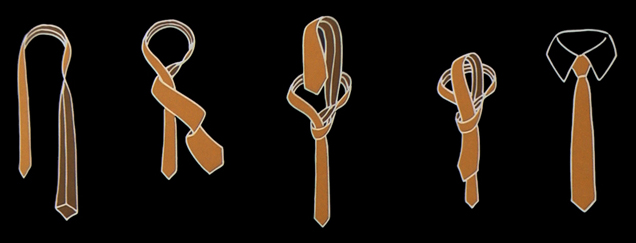 The Kent tie knot – How to tie a tie
The Kent tie knot – How to tie a tie
Taking into account the number of steps, the least complicated the node Kent – also known as node “simple”, but commonly referred to as a simple Four-in-hand.
Kent knot is also known as the “small knot” and this term very well suits him: he has less movement than entangling Four-in-hand. You can make a knot using only a trick (see below), which just makes it more complicated than it first appears.
It is difficult to advise you on the best deals on the tie Kent – a lot depends on the material and its quality. In the case of light fabrics and narrow tie knot comes out very one-dimensional (flat) and very small. However it is good to use it when the only tie that you have available (eg rental), is quite short, and you are high. But – as well as oriental knot – Kent can tie the tie-wide or a very thick material. Kent silk, tweed or wool suits or narrow: only slightly wider collars and makes a good impression both at work and during dinner at the restaurant.
Create tie around the neck, like you used to do it. Depending on the height, the narrow end may be slightly lower than those normally adopted position, since the node using even less material than in the case of four-in-hand. Before you tie, turn the wide end of the tie through 180 degrees. This turn stiffens the tie and allow the next steps easier to form a knot.
 The Kent tie knot is another small tie knot. Just like the Four in Hand tie knot, it only takes one wrapping of the wider part of the tie around the knot. Less of the ties lengths is used when tying this type of necktie knot, which will give the tie an extra 2-3 inches. Just like the Four in Hand tie knot, the Kent knot is often times chosen by tall men that are tying a regular length tie. If you are tall and want to tie larger tie knots, then we recommend extra long ties. At cheap neckties we offer a wide range of XL neckties.
The Kent tie knot is another small tie knot. Just like the Four in Hand tie knot, it only takes one wrapping of the wider part of the tie around the knot. Less of the ties lengths is used when tying this type of necktie knot, which will give the tie an extra 2-3 inches. Just like the Four in Hand tie knot, the Kent knot is often times chosen by tall men that are tying a regular length tie. If you are tall and want to tie larger tie knots, then we recommend extra long ties. At cheap neckties we offer a wide range of XL neckties.
What is the difference between the Four in Hand tie knot and the Kent knot? Although both tie knots are small, the Kent knot is more triangular, while the Four in Hand tie knot necktie knot has a longer shape. This is because the Kent knot is started by wrapping the wide part of the tie from behind, and then around the narrow part. As a result only a single layer will be at the front of the knot.
Matching the Kent knot to tie and shirt:
As with every tie knot, look at the collar spread of your shirt before tying your tie. The smaller the knot, the narrower the collar spread should be. The tie knot should fill most of the gap between the collars. The Kent knot is a smaller tie knot, and should be worn with shirts having a narrow color spread. Another thing to look at is the fabric, more the thickness, of the tie. For the Kent knot it is recommended to use a slightly thicker tie or a tie made from woven silk.
The Kent tie knot – How to tie a tie
Flip up your shirt collar and put the tie around your neck so that he wide part hangs down on your left side. Then twist the wide part of the tie by 180 degrees (simple turn the tie over once). This is important because we start this tie knot going first behind the narrow part.
Cross the narrow part of the tie from behind with the wider part of the necktie.
Now, take the wide part and wrap it around the front of the narrow part of the tie.
Wrap the tie around the part coming from your right collar. Dont tighten the tie to much, but create a loop in front of the knot. Then take the wide part of the tie and pull it through the loop.
Advantage: t is a symmetric necktie knot with an average size (sits between the four-in-hand knot and the half-Windsor knot). It does not look too wide or too narrow.It looks neat.
Disadvantage: The back of the narrow end of the necktie faces up, which does not look good if it is not well hidden behind the wide end.
Suitable Outfits / Occasions: It is suitable for most shirts and occasions.
In a few words
- – Small collar
- – From materials of medium thick and thick
- – Small
- – For men patient and precise
- – To wider ties
- – Asymmetric
- – Does not resolve itself
- – Suitable especially for tall men
- – The material suitable for the billable operation
